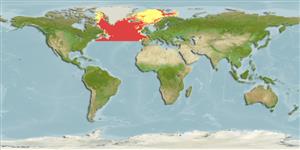Environment: milieu / climate zone / Tiefenbereich / distribution range
Ökologie
seewasser bathypelagisch; ozeanodrom (Ref. 51243); tiefenbereich 300 - 1441 m (Ref. 58426). Deep-water; 79°N - 41°N, 67°W - 35°E
Eastern Atlantic: Norwegian Sea from Lofoten Island northward to the western and northern coasts of Spitsbergen; southern part of the Barents Sea rarely to 35°E , on the Iceland-Faroes Ridge, Iceland and Greenland. Western Atlantic: Baffin Bay to Nova Scotia in Canada (Ref. 7251).
Length at first maturity / Size / Gewicht / Alter
Geschlechtsreife: Lm 43.1 range ? - ? cm
Max length : 77.5 cm TL Männchen/unbestimmt; (Ref. 106276); max. veröff. Alter: 75 Jahre (Ref. 45673)
Inhabit deep waters (Ref. 4570). Epibenthic-pelagic (Ref. 58426). Bear live young. Gregarious throughout life. Feed on euphausiids, hyperiids, cephalopods, chaetognaths and small fishes. Ovoviviparous (Ref. 4570). Longevity was determined from isotope ratios and given as at least 65 years in general and at least 75 years in the waters off Nova Scotia (Ref. 45673).
Ovoviviparous.
Hureau, J.-C. and N.I. Litvinenko, 1986. Scorpaenidae. p. 1211-1229. In P.J.P. Whitehead, M.-L. Bauchot, J.-C. Hureau, J. Nielsen and E. Tortonese (eds.) Fishes of the North-eastern Atlantic and the Mediterranean. UNESCO, Paris. Vol 3. (Ref. 4570)
IUCN Rote Liste Status (Ref. 130435: Version 2025-1)
Bedrohung für Menschen
Harmless
Nutzung durch Menschen
Fischereien: kommerziell
Tools
Zusatzinformationen
Download XML
Internet Quellen
Estimates based on models
Preferred temperature (Ref.
123201): 0.4 - 6.6, mean 3.6 °C (based on 151 cells).
Phylogenetic diversity index (Ref.
82804): PD
50 = 0.5000 [Uniqueness, from 0.5 = low to 2.0 = high].
Bayesian length-weight: a=0.00851 (0.00513 - 0.01411), b=3.04 (2.90 - 3.18), in cm total length, based on LWR estimates for this species & Genus-body shape (Ref.
93245).
Trophic level (Ref.
69278): 4.2 ±0.61 se; based on food items.
Generation time: 14.1 (10.3 - 18.9) years. Estimated as median ln(3)/K based on 11
growth studies.
Widerstandsfähigkeit (Ref.
120179): sehr niedrig, Verdopplung der Population dauert mehr als 14 Jahre. (K=0.05-0.10; tm=10-13).
Prior r = 0.18, 95% CL = 0.12 - 0.26, Based on 10 full stock assessments.
Fishing Vulnerability (Ref.
59153): High to very high vulnerability (72 of 100).
🛈
Climate Vulnerability (Ref.
125649): Moderate vulnerability (42 of 100).
🛈
Nutrients (Ref.
124155): Calcium = 12.1 [5.8, 36.4] mg/100g; Iron = 0.194 [0.085, 0.601] mg/100g; Protein = 18.3 [16.7, 19.7] %; Omega3 = 0.359 [0.105, 1.161] g/100g; Selenium = 43.1 [16.9, 112.9] μg/100g; VitaminA = 34.8 [4.6, 255.9] μg/100g; Zinc = 0.311 [0.186, 0.705] mg/100g (wet weight); based on
nutrient studies.
